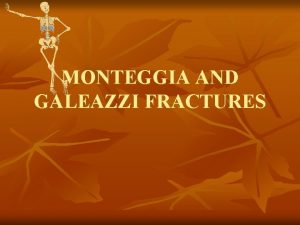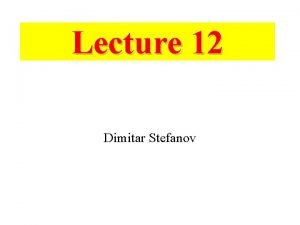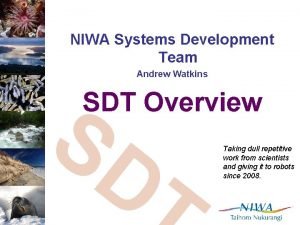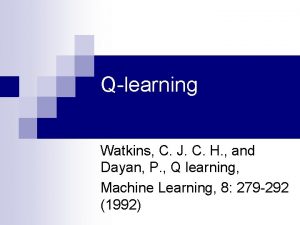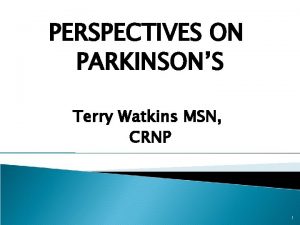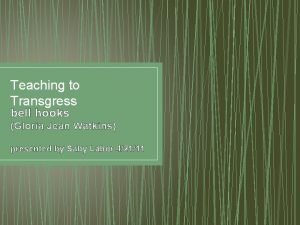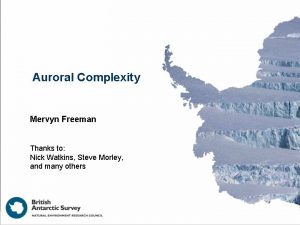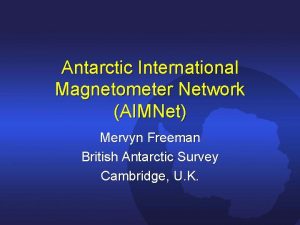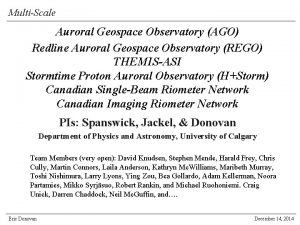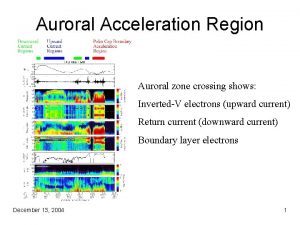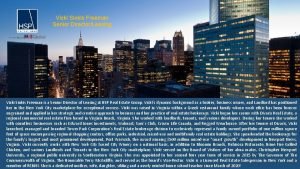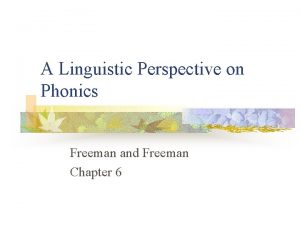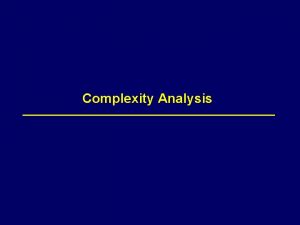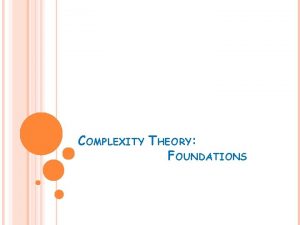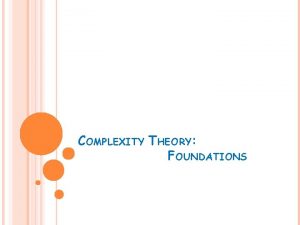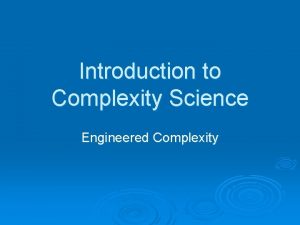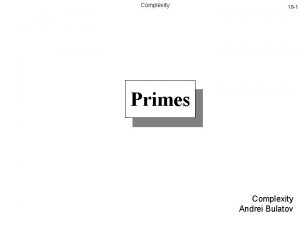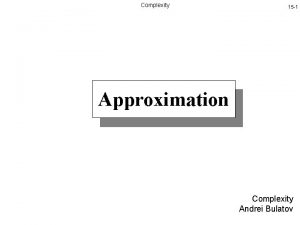Auroral Complexity Mervyn Freeman Thanks to Nick Watkins










![[Freeman and Morley, Geophys Res Lett, 2004] Emergent substorm • Substorm is not part [Freeman and Morley, Geophys Res Lett, 2004] Emergent substorm • Substorm is not part](https://slidetodoc.com/presentation_image/4f110d00405ea91697cd23f8ccd5b576/image-11.jpg)

![“Fractals: Where’s the physics? ” [Kadanoff, 1986] • Shown fractal structure of auroral intensity, “Fractals: Where’s the physics? ” [Kadanoff, 1986] • Shown fractal structure of auroral intensity,](https://slidetodoc.com/presentation_image/4f110d00405ea91697cd23f8ccd5b576/image-13.jpg)


- Slides: 15

Auroral Complexity Mervyn Freeman Thanks to: Nick Watkins, Steve Morley, and many others

Auroral Complexity • Traditional reductionist view - the auroral zoo • New holistic view based on complexity theory – fractal aurora – breakdown of fractality at system scale • Physical models – self-organised criticality, turbulence, percolation • Comparative auroras – open questions? • Conclusions

Reductionist view • Over the years, certain auroral structures have been identified at different spatial and temporal scales: – curl – spiral – omega band – trans-polar arc – westward travelling surge – poleward boundary intensifications – substorm bulge – etc An auroral spiral seen from the ground. Image taken by an all-sky imager with 557 nm filter at 00: 41: 40 UT, 22 March 1997, at Kilpisjarvi, Finland [Courtesy: K. Kauristie, FMI]

Complicated aurora • However, if we look at aurora as a whole (over all time and space) we get another picture – many unidentified structures – dynamic – wide range of scales – interaction between scales • How can we study such behaviour? • Does it have simplifying descriptions and explanations? Movie of aurora above the northern hemisphere Taken by Ultra-Violet Imager on NASA Polar satellite, 10: 01 -23: 02 UT, 10 January 1997 [Courtesy G. Parks, UC Berkeley]

Complexity Periodic • Behaviour of systems with many interacting parts – non-equilibrium – non-linear Complex • Lies between the steady-state, periodic and random ideals that most scientists like to explain! • Involves behaviour of the whole, not just one part or limited set of parts – holistic, not reductionist – whole greater than sum of parts Random

A Hope • “The simplicity of nature is not to be measured by that of our conceptions. Infinitely varied in its effects, nature is simple only in its causes, and its economy consists in producing a great number of phenomena, often very complicated, by means of a small number of general laws” Pierre Laplace (1749 -1827)

Methodology • Complex systems may have universal properties and models – how the many parts interact, not what those parts actually are • Universal properties – non-Gaussian, long-range correlated, self-similar (scale-free) • Universal models – random walks, fractals, networks, Self-Organised Criticality

Complex aurora • Structure can be studied using methods of statistical physics • Track bright patches in the aurora in time and space – Spacecraft imager [Uritsky et al. , 2002] – All-sky imager [Kozelov et al. , 2004] • Aurora is fractal – no characteristic duration or size – for any given duration there are • 5 times fewer patches that last twice as long and • 5 times more patches that last half as long – similarly for area Adapted from Freeman and Watkins [Science, 2002]

Complex Auroral Currents • Similar structure previously observed in Auroral Electrojet (AE) indices • Track magnetic disturbance from peak auroral currents – AU = eastward current • Measure durations of “bright patches” in auroral currents – when AU or AL above arbitrary fixed threshold • AE stations Locations of AE index stations relative to possible moving auroral patch Amplitude – AL = westward current auroral patch motion T Time Example of thresholding data to find “bright patch” duration

Complex auroral currents • Probability density function (PDF) comprises two components [Freeman et al, Geophys Res Lett, 2000] • Fractal aurora – power law (exponential truncation) – driven by solar wind? • Substorm – lognormal centred on 1 -2 h – dominant in nightside AL index • Substorm component not reported in auroral imager analysis – short, non-continuous observation PDF of durations above threshold for AU and -AL index Using thresholds at median of cumulative distribution function Dashed curves are a power law with exponential cut-off and a lognormal.
![Freeman and Morley Geophys Res Lett 2004 Emergent substorm Substorm is not part [Freeman and Morley, Geophys Res Lett, 2004] Emergent substorm • Substorm is not part](https://slidetodoc.com/presentation_image/4f110d00405ea91697cd23f8ccd5b576/image-11.jpg)
[Freeman and Morley, Geophys Res Lett, 2004] Emergent substorm • Substorm is not part of fractal aurora – has characteristic scale – global-scale energy release event • May allow deterministic description • Minimal substorm model [Freeman and Morley, GRL, 2004] – simple “integrate-and-fire” model – explains waiting time between substorms • Probability distribution of substorm waiting times from observation [Borovsky et al. , J. Geophys. Res. , 98, 3807, 1993] (thick line, diamonds) and model (thin line, stars). Also explains substorm occurrence at Jupiter [Kronberg et al, in preparation, 2006] • … and neuron activity in fly’s brain! Probability distribution of neuron spike waiting times from observation (grey bars) and model (thin line). [Brenner et al. , Phys. Rev. Lett. , 1998]

Complex auroral convection • Structure function analysis of auroral convection measured by Super. DARN [Abel and Freeman, 2006] • Non-Gaussian distribution of velocity fluctuations at different spatial separations • Can be re-scaled by power-law transformation • Velocity fluctuations are fractal in space and time
![Fractals Wheres the physics Kadanoff 1986 Shown fractal structure of auroral intensity “Fractals: Where’s the physics? ” [Kadanoff, 1986] • Shown fractal structure of auroral intensity,](https://slidetodoc.com/presentation_image/4f110d00405ea91697cd23f8ccd5b576/image-13.jpg)
“Fractals: Where’s the physics? ” [Kadanoff, 1986] • Shown fractal structure of auroral intensity, currents and convection • Physical mechanisms for spatio-temporal fractality include: – Self-Organised Criticality [Chang, IEEE Trans. Plasma Sci. , 1992] • non-linear diffusion – Turbulence [Dungey, Phys. Rev. Lett, 1961; Coleman, Astrophys. J. , 1968] • non-linear advection – Percolation [Milovanov et al. , J. Geophys. Res. , 2001] • critical branching (paths through randomly defected media)

Comparative auroras – questions • Are all planetary auroras fractal up to the system scale? • Do they belong to the same universality class? • Does minimal substorm model explain substorm occurrence at Saturn, mini-magnetospheres, etc • Please help me to find out! • Planetary science community has exciting data to provide answers

Conclusions • New holistic view of aurora based on complexity theory – complementary to traditional reductionist approach • Auroral intensity, current and convection are fractal in time and space – self-similar from seconds to hours, 1 km to global scale (1000 km) • Possible models: SOC, turbulence, percolation • Breakdown in fractality at global scale – substorm – Mimimal substorm model explains substorm waiting times • Complexity gives new ideas for familiar earth system problems • Can these be helpful for understanding planetary aurora too? – MSM explains substorm occurrence at Jupiter
 Mervyn evans
Mervyn evans Mervyn evans
Mervyn evans Time and space complexity
Time and space complexity Sherron watkins
Sherron watkins Physician associate lecturer
Physician associate lecturer Jeannie watkins princess cruises
Jeannie watkins princess cruises Stees v. leonard
Stees v. leonard Watkins creek franklin tn
Watkins creek franklin tn Abraham watkins
Abraham watkins Greenhouse framework
Greenhouse framework Watkins q learning
Watkins q learning Cassandra watkins
Cassandra watkins Abraham watkins nichols sorrels agosto & friend
Abraham watkins nichols sorrels agosto & friend Abraham watkins
Abraham watkins Bell hooks engaged pedagogy summary
Bell hooks engaged pedagogy summary Watkins block
Watkins block
